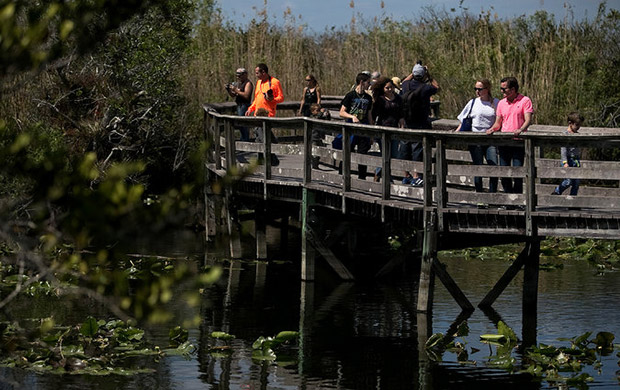
By LIZETTE ALVAREZAPRIL
www.nytimes.com
MIAMI — Facing a thicket of candidates and ballot measures in the November election, Florida voters sent one resounding message to elected officials: More must be done to protect the state’s natural habitats — including the long-suffering Everglades.
But as the Legislature heads into the final days of this year’s session, Republican leaders are being criticized for the way they are divvying up a $750 million pool of money created to buy, conserve and restore land and water resources. It was established when three-quarters of Florida voters approved constitutional Amendment 1, which sets aside part of a real estate tax.
The amendment was intended to bolster a popular conservation program, Florida Forever, that had been hard hit by state budget cuts. But instead of using the bulk of the money to safeguard land from development, supporters of the amendment say, state lawmakers have shifted it to other projects and programs.
Continue reading the main story
RELATED COVERAGE
President Obama during a tour Wednesday of Everglades National Park. “Climate change is threatening this treasure and the communities that depend on it,” he said of the area.Obama Uses a Visit to the Everglades to Press His Climate AgendaAPRIL 22, 2015
“The word ‘land’ appears 18 times in the text of the ballot amendment,” said Will Abberger, the chairman of the Amendment 1 sponsoring committee, who helped lead the arduous task of getting the proposal on the ballot. “We thought the voters sent a pretty loud and clear message.”
Republican legislative leaders, however, see it differently: Florida has already conserved enough land — 5.3 million acres — so using the money for other crucial projects and expenses is a smarter approach. Because Amendment 1 allows funds to go toward land management, it gives them the discretion, they argue, to use the money more broadly, including to pay for day-to-day operations of several state agencies that deal with management.
“We don’t need to be known as the hoarding-land state,” State Senator Alan Hays, a Republican, who is chairman of the Senate Appropriations subcommittee that allocates Amendment 1 money, said during a meeting. “We need to be known as good stewards of the resources that the people own.”
So far, the Republican-controlled Legislature has funneled only a modest amount of money into buying land — not the $300 million share that was expected. Other environmental initiatives, including protection of springs, are also languishing. And a pivotal component of a long-term plan to restore the Everglades — acquiring land from the U.S. Sugar Corporation to help increase the flow of water into the Everglades — appears to be off the table entirely.
“The Legislature is showing how out of sync they are with voters and how much they hate the amendment,” said Eric Draper, the executive director of the Audubon Society of Florida. “If they can find a way to pay for paper towels in the washroom with Amendment 1 money, they would do it.”
In Florida, where the battle over development is constant, buying land is seen as the surest way to protect natural resources. Florida started its program — the largest in the country — under Gov. Bob Martinez, a Republican, in 1990. The program, later called Florida Forever, was embraced by Gov. Jeb Bush.
But then a recession, coupled in 2011 with a Legislature that often catered to business, and Gov. Rick Scott’s emphasis on jobs, nearly decimated the program. Money dried up, scientists said, at a time when Florida’s springs, estuaries, rivers, lakes and coral reefs were being hurt by factors ranging from waste and fertilizer runoff to water consumption and climate change.
Voters acted to correct this in November by providing a dedicated stream of money for 20 years to Florida Forever.
Of the $750 million in the Amendment 1 budget, the Florida House approved $10.5 million for land on Florida Forever’s conservation and restoration priority list, environmentalists said. An additional $90 million, through bonds, would go toward buying land for springs protection and restoring the Kissimmee River among other projects, which, while laudable, fall outside Florida Forever, Mr. Abberger said.
The speaker of the House, Steve Crisafulli, “believes it is irresponsible to buy land that falls into disrepair or becomes a breeding ground for harmful invasive species,” his communications director, Michael Williams, said. Mr. Crisafulli, though, is not opposed to “long-term strategic” land buying.
The Senate approved $17 million for Florida Forever after the $2 million it initially proposed unleashed a torrent of angry emails from conservation supporters. It budgeted an additional $20 million for springs. The two chambers must now reach a final agreement on the budgets by May 1.
A large share of Amendment 1 money — more than $230 million — would go toward state agency operations and regulatory expenses, including paying for the salaries of state employees. Ordinarily, these expenses are paid through the general pool of appropriations, not the special tax.
“There is a shell game of sorts going on,” said Jennifer Hecker, director of natural resource policy for the Conservancy of Southwest Florida. “It’s a bait and switch.”
Environmentalists said they were hoping that Mr. Scott, who proposed $100 million for Florida Forever, would pressure the Legislature to increase the amount. But the governor has so far not wrangled with the Legislature on the environment.
Other sensitive issues, including water pollution controls, also have been diminished. A much-hoped-for Senate bill to protect Florida’s springs from growing pollution and low water flow was weakened this month. The changes came after lobbyists for Florida businesses and agriculture told lawmakers that the bill — which would have curbed water pumping permits, among other things — was too strict and could hurt businesses.
Action is needed, scientists say, because Florida’s incomparable landscape continues to decline. Once crystal-clear freshwater springs have grown murky with algae. Critical estuaries, the breeding ground for marine life, have languished because of polluted water from Lake Okeechobee. And the Everglades are still reeling from thirst, something that also affects South Florida’s dwindling water supply.
Perhaps the biggest environmental battle unfolding is over a component for the Everglades’ restoration. Advocates are pressuring the Legislature to allocate money in the next week to buy 46,800 acres owned by U.S. Sugar, part of an option worked out several years ago under Gov. Charlie Crist. The option expires in October.
Republican leaders and Mr. Scott want to focus on other plans to help the Everglades, including a separate $880 million project to build two reservoirs to store and clean some of the polluted water that flows out of the lake. Mr. Scott also led the effort in 2013 to build a series of bridges to help the flow of the River of Grass, a nickname for the Everglades.
But environmentalists say the U.S. Sugar land, which lies south of Lake Okeechobee, is also needed to help clean the water and push more of it directly into the parched Everglades — not into estuaries to the east and west. (To control for flooding, the Army Corps of Engineers funnels the lake water east and west into estuaries that have been badly damaged by the polluted water.) The idea is to build a reservoir on the land, which was bought decades ago by sugar companies, to make that happen.
If the land is not purchased soon, the option will expire and the deal must be renegotiated.
“While all the other projects are equally important pieces of an interconnected puzzle, this missing piece is also necessary,” Ms. Hecker said. “Without this, at the end of the day we won’t be successful.”
U.S. Sugar, part of a powerful industry that donates heavily to lawmakers, championed the deal during the recession. But now the company has backed off the idea, saying the land would not solve the pollution problem.
Action, Mr. Abberger said, is imperative. Development is booming again, the state’s population is surging and land prices are rapidly climbing.
“The next 20 years will be the end game for land conservation in Florida,” Mr. Abberger said. “If it’s not acquired and conserved, it will be gone.”
A version of this article appears in print on April 26, 2015, on page A18 of the New York edition with the headline: Florida Legislature Has Its Own Ideas for Voter-Approved Conservation Fund.



